Business Development Assignment: Tech Action Plan and Open Innovation
VerifiedAdded on 2020/05/16
|11
|2735
|61
Essay
AI Summary
This assignment comprises two parts, exploring key concepts in business development. The first part focuses on developing an action plan for recognizing new technological opportunities, emphasizing the importance of adapting or developing technology to meet strategic needs. It discusses steps like analyzing market trends using the Gartner Hype Cycle, understanding consumer behavior, and assessing the viability of technological options. The second part delves into open innovation, defining it as the strategic exchange of knowledge to accelerate internal innovation and expand markets. It covers the principles of open innovation, including leveraging external ideas, balancing internal and external research, and using business models to create value. The assignment also addresses barriers to open innovation, such as legal regulations and management support, while highlighting its benefits, such as creating competitive products and staying ahead of the competition. The assignment uses examples like Microsoft to illustrate the concepts and their practical applications.
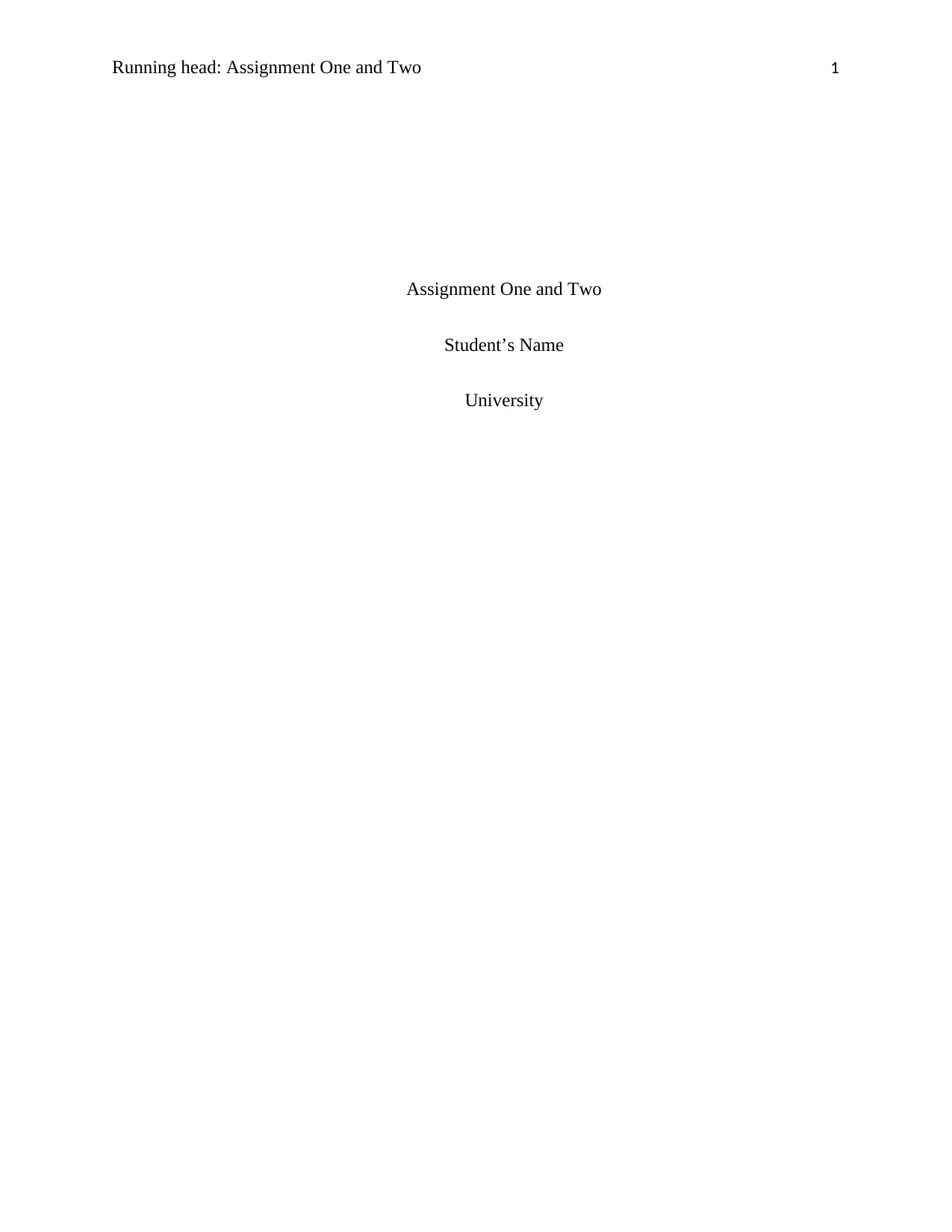
Running head: Assignment One and Two 1
Assignment One and Two
Student’s Name
University
Assignment One and Two
Student’s Name
University
Paraphrase This Document
Need a fresh take? Get an instant paraphrase of this document with our AI Paraphraser
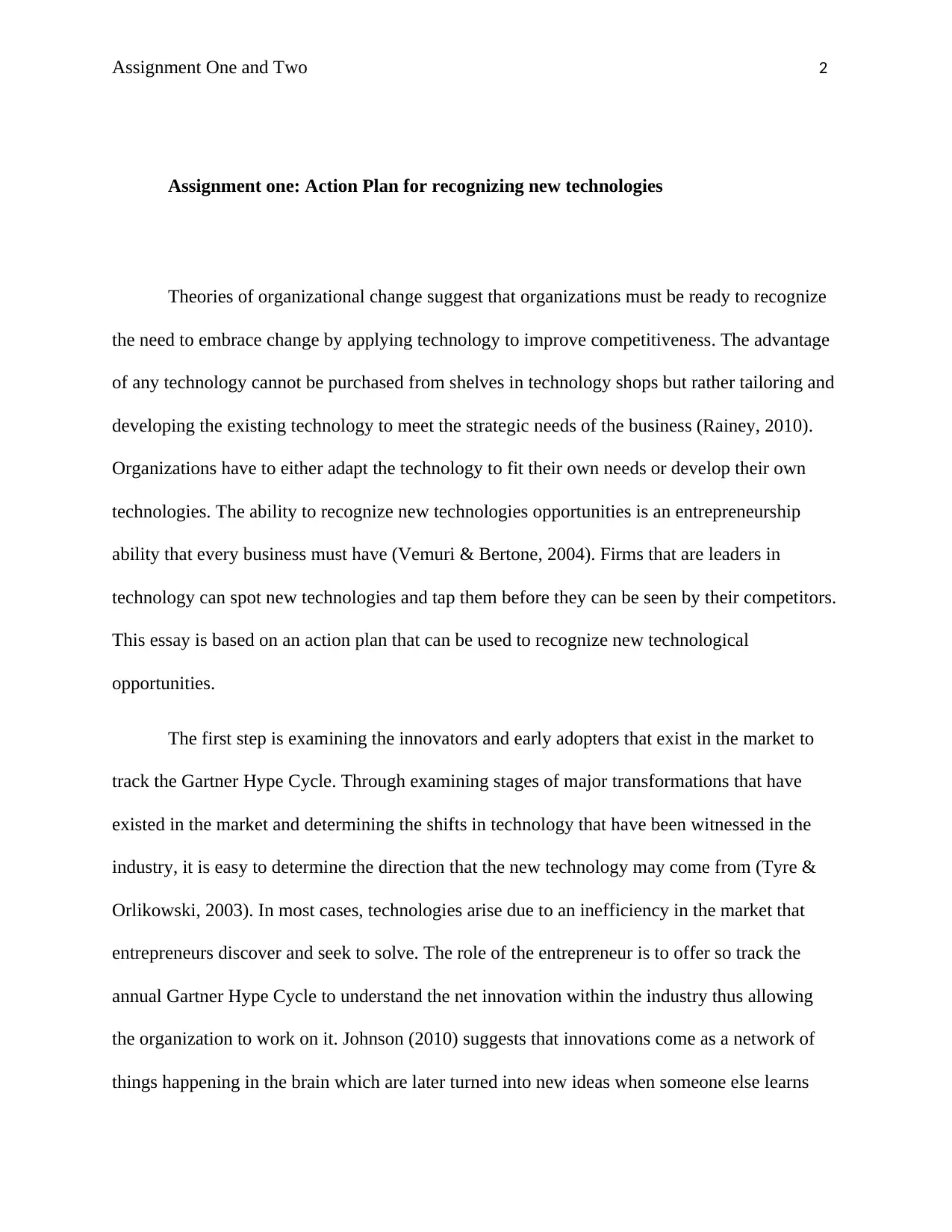
Assignment One and Two 2
Assignment one: Action Plan for recognizing new technologies
Theories of organizational change suggest that organizations must be ready to recognize
the need to embrace change by applying technology to improve competitiveness. The advantage
of any technology cannot be purchased from shelves in technology shops but rather tailoring and
developing the existing technology to meet the strategic needs of the business (Rainey, 2010).
Organizations have to either adapt the technology to fit their own needs or develop their own
technologies. The ability to recognize new technologies opportunities is an entrepreneurship
ability that every business must have (Vemuri & Bertone, 2004). Firms that are leaders in
technology can spot new technologies and tap them before they can be seen by their competitors.
This essay is based on an action plan that can be used to recognize new technological
opportunities.
The first step is examining the innovators and early adopters that exist in the market to
track the Gartner Hype Cycle. Through examining stages of major transformations that have
existed in the market and determining the shifts in technology that have been witnessed in the
industry, it is easy to determine the direction that the new technology may come from (Tyre &
Orlikowski, 2003). In most cases, technologies arise due to an inefficiency in the market that
entrepreneurs discover and seek to solve. The role of the entrepreneur is to offer so track the
annual Gartner Hype Cycle to understand the net innovation within the industry thus allowing
the organization to work on it. Johnson (2010) suggests that innovations come as a network of
things happening in the brain which are later turned into new ideas when someone else learns
Assignment one: Action Plan for recognizing new technologies
Theories of organizational change suggest that organizations must be ready to recognize
the need to embrace change by applying technology to improve competitiveness. The advantage
of any technology cannot be purchased from shelves in technology shops but rather tailoring and
developing the existing technology to meet the strategic needs of the business (Rainey, 2010).
Organizations have to either adapt the technology to fit their own needs or develop their own
technologies. The ability to recognize new technologies opportunities is an entrepreneurship
ability that every business must have (Vemuri & Bertone, 2004). Firms that are leaders in
technology can spot new technologies and tap them before they can be seen by their competitors.
This essay is based on an action plan that can be used to recognize new technological
opportunities.
The first step is examining the innovators and early adopters that exist in the market to
track the Gartner Hype Cycle. Through examining stages of major transformations that have
existed in the market and determining the shifts in technology that have been witnessed in the
industry, it is easy to determine the direction that the new technology may come from (Tyre &
Orlikowski, 2003). In most cases, technologies arise due to an inefficiency in the market that
entrepreneurs discover and seek to solve. The role of the entrepreneur is to offer so track the
annual Gartner Hype Cycle to understand the net innovation within the industry thus allowing
the organization to work on it. Johnson (2010) suggests that innovations come as a network of
things happening in the brain which are later turned into new ideas when someone else learns
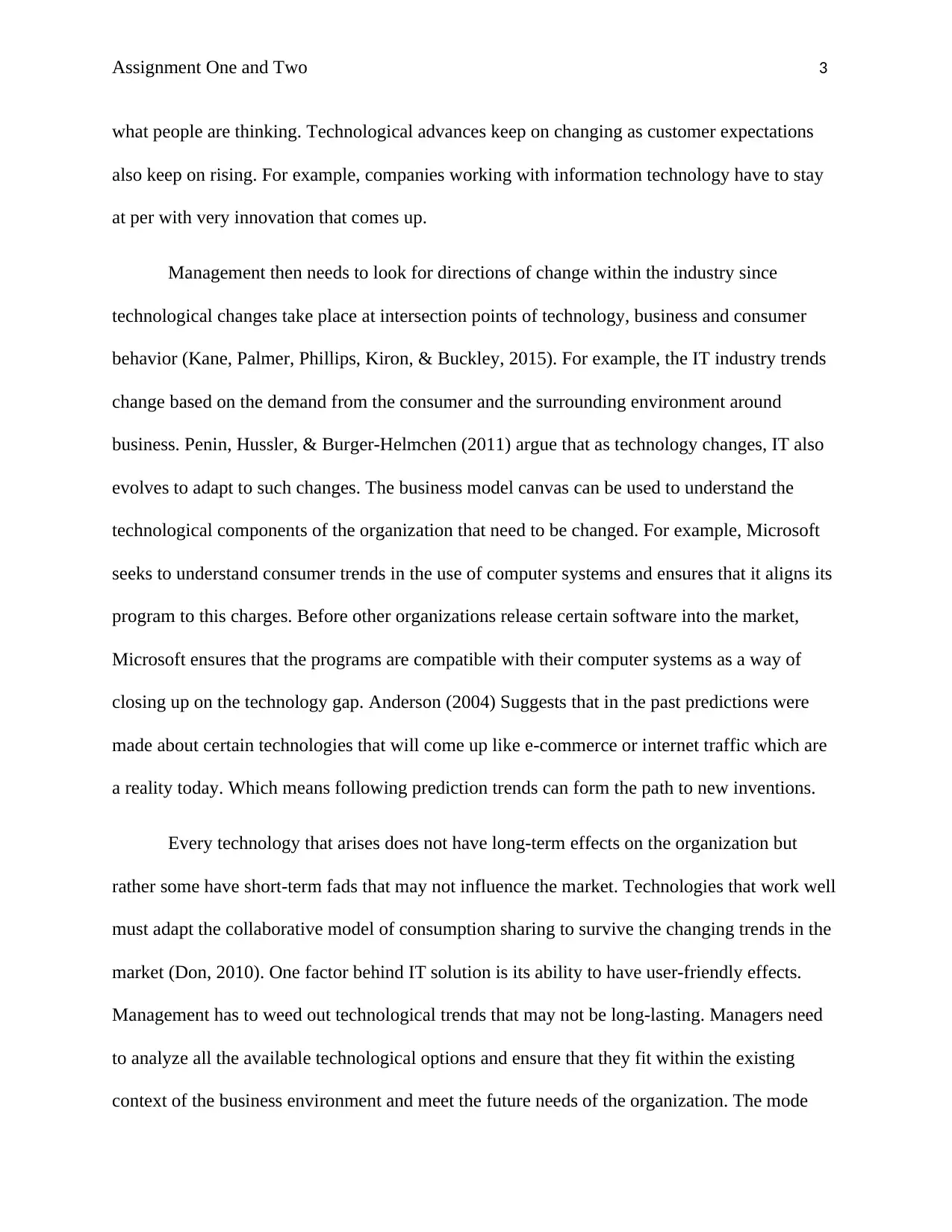
Assignment One and Two 3
what people are thinking. Technological advances keep on changing as customer expectations
also keep on rising. For example, companies working with information technology have to stay
at per with very innovation that comes up.
Management then needs to look for directions of change within the industry since
technological changes take place at intersection points of technology, business and consumer
behavior (Kane, Palmer, Phillips, Kiron, & Buckley, 2015). For example, the IT industry trends
change based on the demand from the consumer and the surrounding environment around
business. Penin, Hussler, & Burger-Helmchen (2011) argue that as technology changes, IT also
evolves to adapt to such changes. The business model canvas can be used to understand the
technological components of the organization that need to be changed. For example, Microsoft
seeks to understand consumer trends in the use of computer systems and ensures that it aligns its
program to this charges. Before other organizations release certain software into the market,
Microsoft ensures that the programs are compatible with their computer systems as a way of
closing up on the technology gap. Anderson (2004) Suggests that in the past predictions were
made about certain technologies that will come up like e-commerce or internet traffic which are
a reality today. Which means following prediction trends can form the path to new inventions.
Every technology that arises does not have long-term effects on the organization but
rather some have short-term fads that may not influence the market. Technologies that work well
must adapt the collaborative model of consumption sharing to survive the changing trends in the
market (Don, 2010). One factor behind IT solution is its ability to have user-friendly effects.
Management has to weed out technological trends that may not be long-lasting. Managers need
to analyze all the available technological options and ensure that they fit within the existing
context of the business environment and meet the future needs of the organization. The mode
what people are thinking. Technological advances keep on changing as customer expectations
also keep on rising. For example, companies working with information technology have to stay
at per with very innovation that comes up.
Management then needs to look for directions of change within the industry since
technological changes take place at intersection points of technology, business and consumer
behavior (Kane, Palmer, Phillips, Kiron, & Buckley, 2015). For example, the IT industry trends
change based on the demand from the consumer and the surrounding environment around
business. Penin, Hussler, & Burger-Helmchen (2011) argue that as technology changes, IT also
evolves to adapt to such changes. The business model canvas can be used to understand the
technological components of the organization that need to be changed. For example, Microsoft
seeks to understand consumer trends in the use of computer systems and ensures that it aligns its
program to this charges. Before other organizations release certain software into the market,
Microsoft ensures that the programs are compatible with their computer systems as a way of
closing up on the technology gap. Anderson (2004) Suggests that in the past predictions were
made about certain technologies that will come up like e-commerce or internet traffic which are
a reality today. Which means following prediction trends can form the path to new inventions.
Every technology that arises does not have long-term effects on the organization but
rather some have short-term fads that may not influence the market. Technologies that work well
must adapt the collaborative model of consumption sharing to survive the changing trends in the
market (Don, 2010). One factor behind IT solution is its ability to have user-friendly effects.
Management has to weed out technological trends that may not be long-lasting. Managers need
to analyze all the available technological options and ensure that they fit within the existing
context of the business environment and meet the future needs of the organization. The mode
⊘ This is a preview!⊘
Do you want full access?
Subscribe today to unlock all pages.

Trusted by 1+ million students worldwide
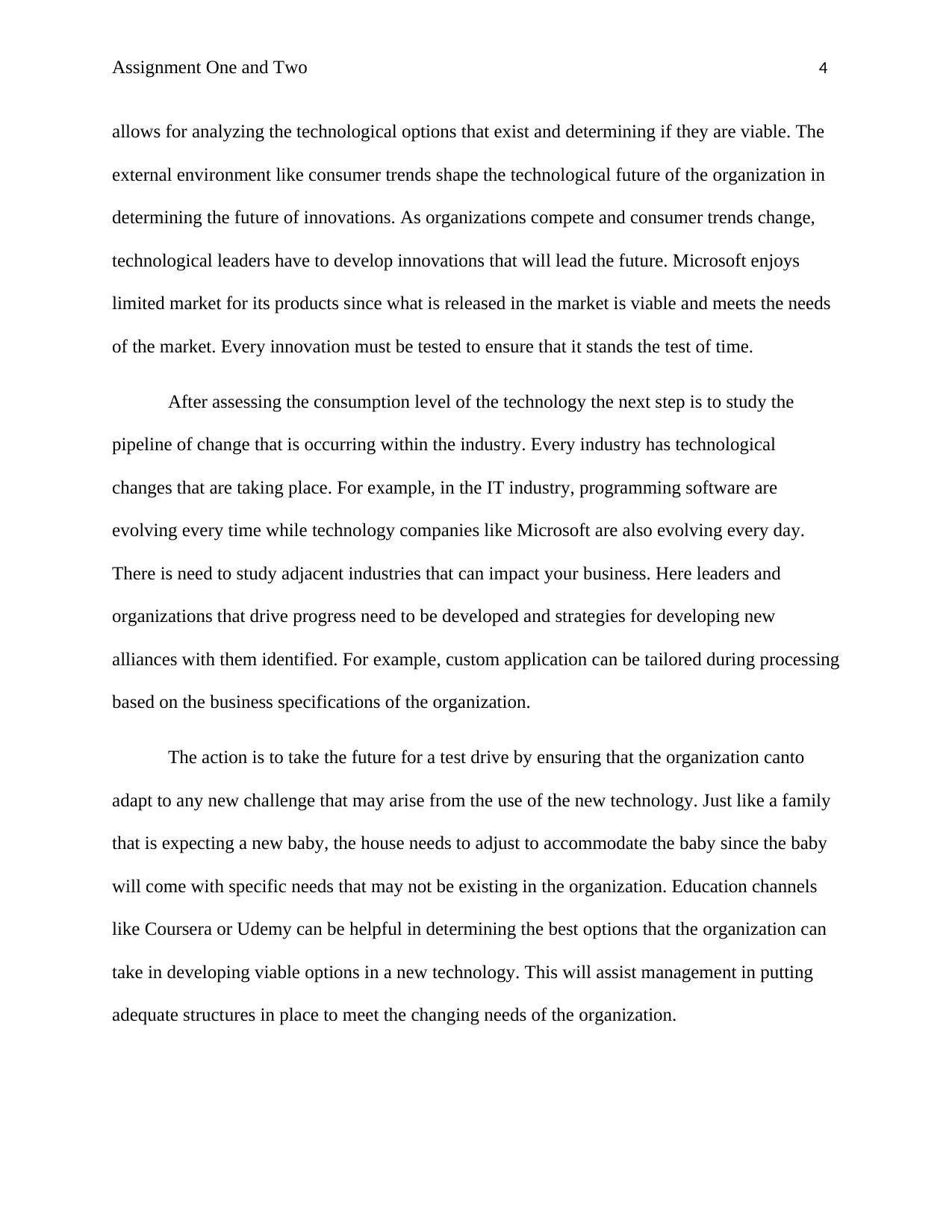
Assignment One and Two 4
allows for analyzing the technological options that exist and determining if they are viable. The
external environment like consumer trends shape the technological future of the organization in
determining the future of innovations. As organizations compete and consumer trends change,
technological leaders have to develop innovations that will lead the future. Microsoft enjoys
limited market for its products since what is released in the market is viable and meets the needs
of the market. Every innovation must be tested to ensure that it stands the test of time.
After assessing the consumption level of the technology the next step is to study the
pipeline of change that is occurring within the industry. Every industry has technological
changes that are taking place. For example, in the IT industry, programming software are
evolving every time while technology companies like Microsoft are also evolving every day.
There is need to study adjacent industries that can impact your business. Here leaders and
organizations that drive progress need to be developed and strategies for developing new
alliances with them identified. For example, custom application can be tailored during processing
based on the business specifications of the organization.
The action is to take the future for a test drive by ensuring that the organization canto
adapt to any new challenge that may arise from the use of the new technology. Just like a family
that is expecting a new baby, the house needs to adjust to accommodate the baby since the baby
will come with specific needs that may not be existing in the organization. Education channels
like Coursera or Udemy can be helpful in determining the best options that the organization can
take in developing viable options in a new technology. This will assist management in putting
adequate structures in place to meet the changing needs of the organization.
allows for analyzing the technological options that exist and determining if they are viable. The
external environment like consumer trends shape the technological future of the organization in
determining the future of innovations. As organizations compete and consumer trends change,
technological leaders have to develop innovations that will lead the future. Microsoft enjoys
limited market for its products since what is released in the market is viable and meets the needs
of the market. Every innovation must be tested to ensure that it stands the test of time.
After assessing the consumption level of the technology the next step is to study the
pipeline of change that is occurring within the industry. Every industry has technological
changes that are taking place. For example, in the IT industry, programming software are
evolving every time while technology companies like Microsoft are also evolving every day.
There is need to study adjacent industries that can impact your business. Here leaders and
organizations that drive progress need to be developed and strategies for developing new
alliances with them identified. For example, custom application can be tailored during processing
based on the business specifications of the organization.
The action is to take the future for a test drive by ensuring that the organization canto
adapt to any new challenge that may arise from the use of the new technology. Just like a family
that is expecting a new baby, the house needs to adjust to accommodate the baby since the baby
will come with specific needs that may not be existing in the organization. Education channels
like Coursera or Udemy can be helpful in determining the best options that the organization can
take in developing viable options in a new technology. This will assist management in putting
adequate structures in place to meet the changing needs of the organization.
Paraphrase This Document
Need a fresh take? Get an instant paraphrase of this document with our AI Paraphraser
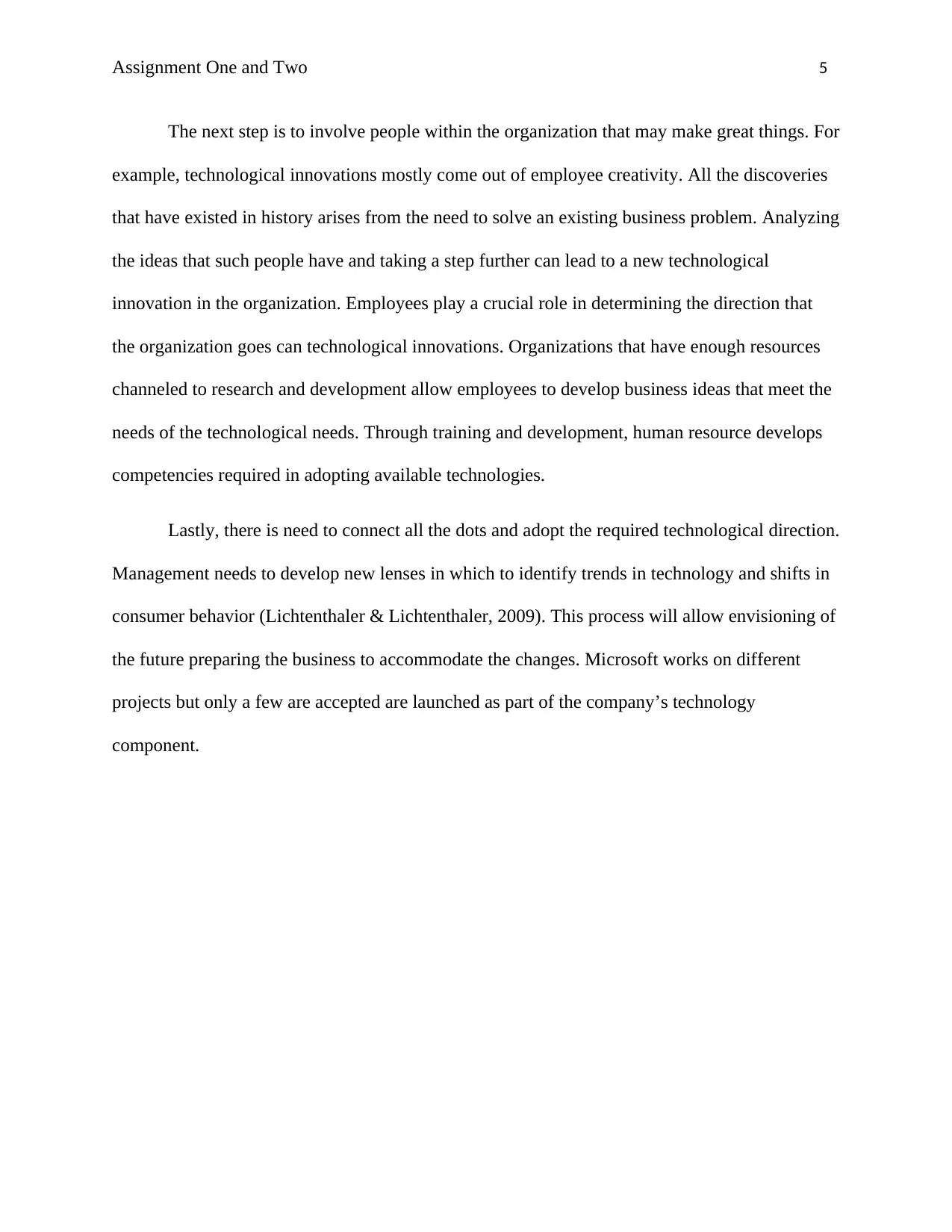
Assignment One and Two 5
The next step is to involve people within the organization that may make great things. For
example, technological innovations mostly come out of employee creativity. All the discoveries
that have existed in history arises from the need to solve an existing business problem. Analyzing
the ideas that such people have and taking a step further can lead to a new technological
innovation in the organization. Employees play a crucial role in determining the direction that
the organization goes can technological innovations. Organizations that have enough resources
channeled to research and development allow employees to develop business ideas that meet the
needs of the technological needs. Through training and development, human resource develops
competencies required in adopting available technologies.
Lastly, there is need to connect all the dots and adopt the required technological direction.
Management needs to develop new lenses in which to identify trends in technology and shifts in
consumer behavior (Lichtenthaler & Lichtenthaler, 2009). This process will allow envisioning of
the future preparing the business to accommodate the changes. Microsoft works on different
projects but only a few are accepted are launched as part of the company’s technology
component.
The next step is to involve people within the organization that may make great things. For
example, technological innovations mostly come out of employee creativity. All the discoveries
that have existed in history arises from the need to solve an existing business problem. Analyzing
the ideas that such people have and taking a step further can lead to a new technological
innovation in the organization. Employees play a crucial role in determining the direction that
the organization goes can technological innovations. Organizations that have enough resources
channeled to research and development allow employees to develop business ideas that meet the
needs of the technological needs. Through training and development, human resource develops
competencies required in adopting available technologies.
Lastly, there is need to connect all the dots and adopt the required technological direction.
Management needs to develop new lenses in which to identify trends in technology and shifts in
consumer behavior (Lichtenthaler & Lichtenthaler, 2009). This process will allow envisioning of
the future preparing the business to accommodate the changes. Microsoft works on different
projects but only a few are accepted are launched as part of the company’s technology
component.
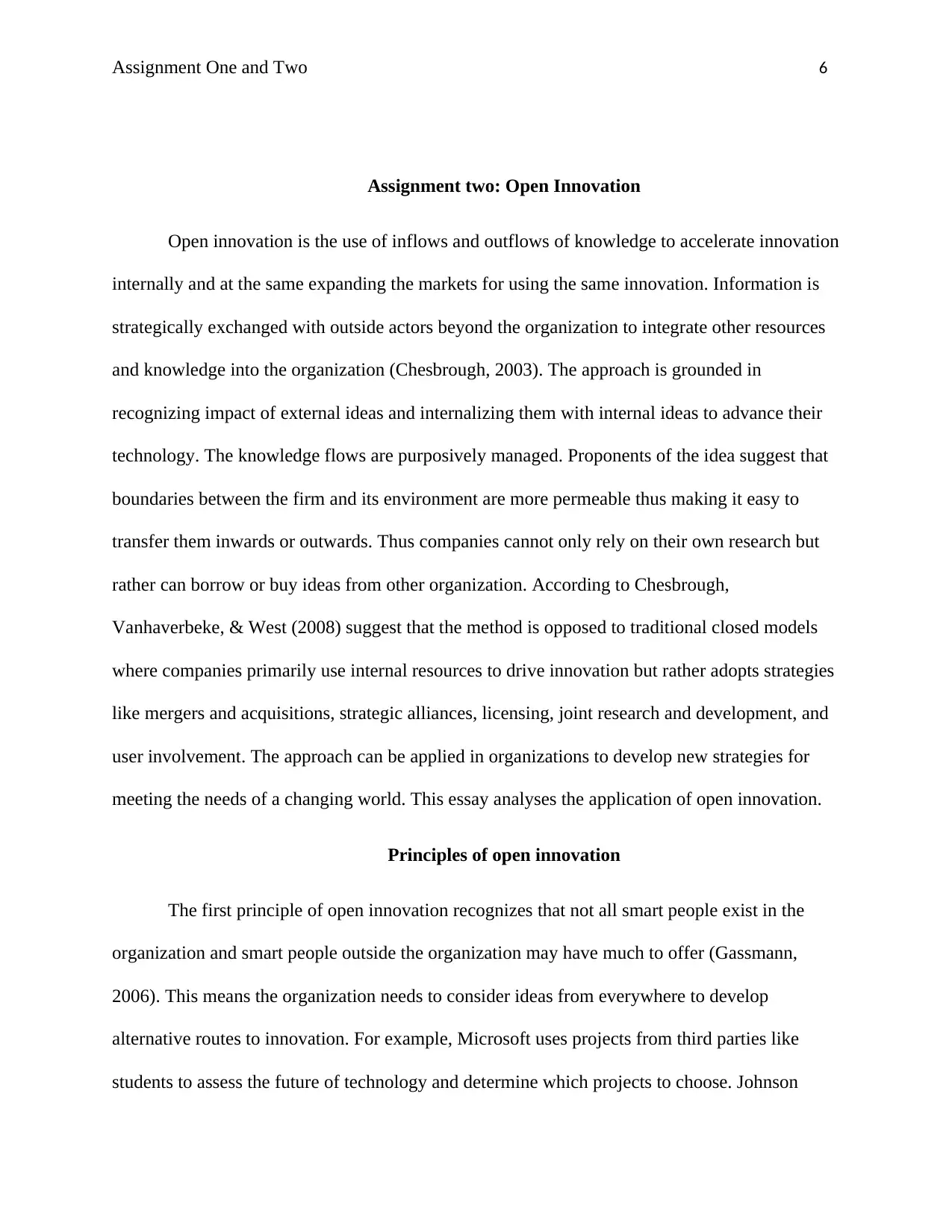
Assignment One and Two 6
Assignment two: Open Innovation
Open innovation is the use of inflows and outflows of knowledge to accelerate innovation
internally and at the same expanding the markets for using the same innovation. Information is
strategically exchanged with outside actors beyond the organization to integrate other resources
and knowledge into the organization (Chesbrough, 2003). The approach is grounded in
recognizing impact of external ideas and internalizing them with internal ideas to advance their
technology. The knowledge flows are purposively managed. Proponents of the idea suggest that
boundaries between the firm and its environment are more permeable thus making it easy to
transfer them inwards or outwards. Thus companies cannot only rely on their own research but
rather can borrow or buy ideas from other organization. According to Chesbrough,
Vanhaverbeke, & West (2008) suggest that the method is opposed to traditional closed models
where companies primarily use internal resources to drive innovation but rather adopts strategies
like mergers and acquisitions, strategic alliances, licensing, joint research and development, and
user involvement. The approach can be applied in organizations to develop new strategies for
meeting the needs of a changing world. This essay analyses the application of open innovation.
Principles of open innovation
The first principle of open innovation recognizes that not all smart people exist in the
organization and smart people outside the organization may have much to offer (Gassmann,
2006). This means the organization needs to consider ideas from everywhere to develop
alternative routes to innovation. For example, Microsoft uses projects from third parties like
students to assess the future of technology and determine which projects to choose. Johnson
Assignment two: Open Innovation
Open innovation is the use of inflows and outflows of knowledge to accelerate innovation
internally and at the same expanding the markets for using the same innovation. Information is
strategically exchanged with outside actors beyond the organization to integrate other resources
and knowledge into the organization (Chesbrough, 2003). The approach is grounded in
recognizing impact of external ideas and internalizing them with internal ideas to advance their
technology. The knowledge flows are purposively managed. Proponents of the idea suggest that
boundaries between the firm and its environment are more permeable thus making it easy to
transfer them inwards or outwards. Thus companies cannot only rely on their own research but
rather can borrow or buy ideas from other organization. According to Chesbrough,
Vanhaverbeke, & West (2008) suggest that the method is opposed to traditional closed models
where companies primarily use internal resources to drive innovation but rather adopts strategies
like mergers and acquisitions, strategic alliances, licensing, joint research and development, and
user involvement. The approach can be applied in organizations to develop new strategies for
meeting the needs of a changing world. This essay analyses the application of open innovation.
Principles of open innovation
The first principle of open innovation recognizes that not all smart people exist in the
organization and smart people outside the organization may have much to offer (Gassmann,
2006). This means the organization needs to consider ideas from everywhere to develop
alternative routes to innovation. For example, Microsoft uses projects from third parties like
students to assess the future of technology and determine which projects to choose. Johnson
⊘ This is a preview!⊘
Do you want full access?
Subscribe today to unlock all pages.

Trusted by 1+ million students worldwide
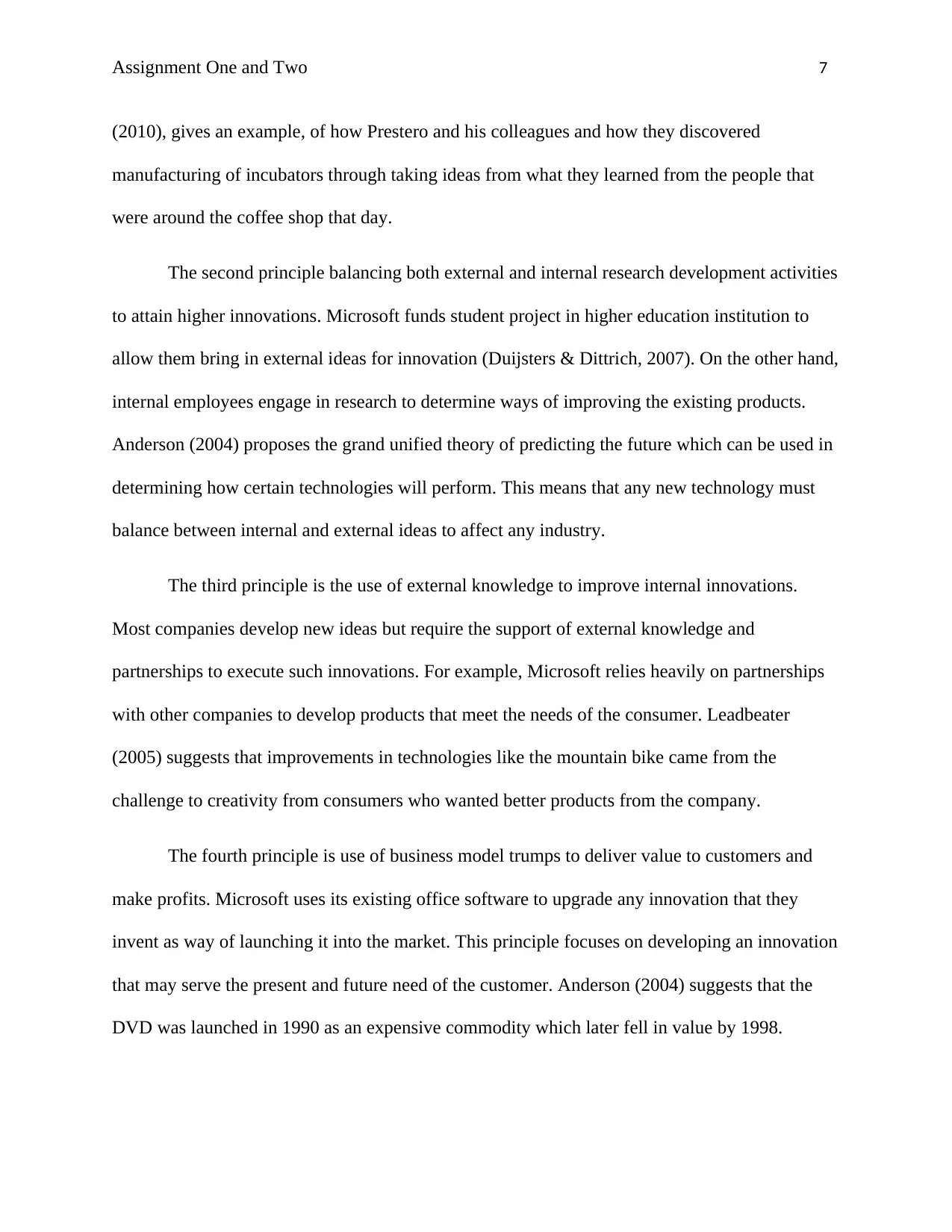
Assignment One and Two 7
(2010), gives an example, of how Prestero and his colleagues and how they discovered
manufacturing of incubators through taking ideas from what they learned from the people that
were around the coffee shop that day.
The second principle balancing both external and internal research development activities
to attain higher innovations. Microsoft funds student project in higher education institution to
allow them bring in external ideas for innovation (Duijsters & Dittrich, 2007). On the other hand,
internal employees engage in research to determine ways of improving the existing products.
Anderson (2004) proposes the grand unified theory of predicting the future which can be used in
determining how certain technologies will perform. This means that any new technology must
balance between internal and external ideas to affect any industry.
The third principle is the use of external knowledge to improve internal innovations.
Most companies develop new ideas but require the support of external knowledge and
partnerships to execute such innovations. For example, Microsoft relies heavily on partnerships
with other companies to develop products that meet the needs of the consumer. Leadbeater
(2005) suggests that improvements in technologies like the mountain bike came from the
challenge to creativity from consumers who wanted better products from the company.
The fourth principle is use of business model trumps to deliver value to customers and
make profits. Microsoft uses its existing office software to upgrade any innovation that they
invent as way of launching it into the market. This principle focuses on developing an innovation
that may serve the present and future need of the customer. Anderson (2004) suggests that the
DVD was launched in 1990 as an expensive commodity which later fell in value by 1998.
(2010), gives an example, of how Prestero and his colleagues and how they discovered
manufacturing of incubators through taking ideas from what they learned from the people that
were around the coffee shop that day.
The second principle balancing both external and internal research development activities
to attain higher innovations. Microsoft funds student project in higher education institution to
allow them bring in external ideas for innovation (Duijsters & Dittrich, 2007). On the other hand,
internal employees engage in research to determine ways of improving the existing products.
Anderson (2004) proposes the grand unified theory of predicting the future which can be used in
determining how certain technologies will perform. This means that any new technology must
balance between internal and external ideas to affect any industry.
The third principle is the use of external knowledge to improve internal innovations.
Most companies develop new ideas but require the support of external knowledge and
partnerships to execute such innovations. For example, Microsoft relies heavily on partnerships
with other companies to develop products that meet the needs of the consumer. Leadbeater
(2005) suggests that improvements in technologies like the mountain bike came from the
challenge to creativity from consumers who wanted better products from the company.
The fourth principle is use of business model trumps to deliver value to customers and
make profits. Microsoft uses its existing office software to upgrade any innovation that they
invent as way of launching it into the market. This principle focuses on developing an innovation
that may serve the present and future need of the customer. Anderson (2004) suggests that the
DVD was launched in 1990 as an expensive commodity which later fell in value by 1998.
Paraphrase This Document
Need a fresh take? Get an instant paraphrase of this document with our AI Paraphraser
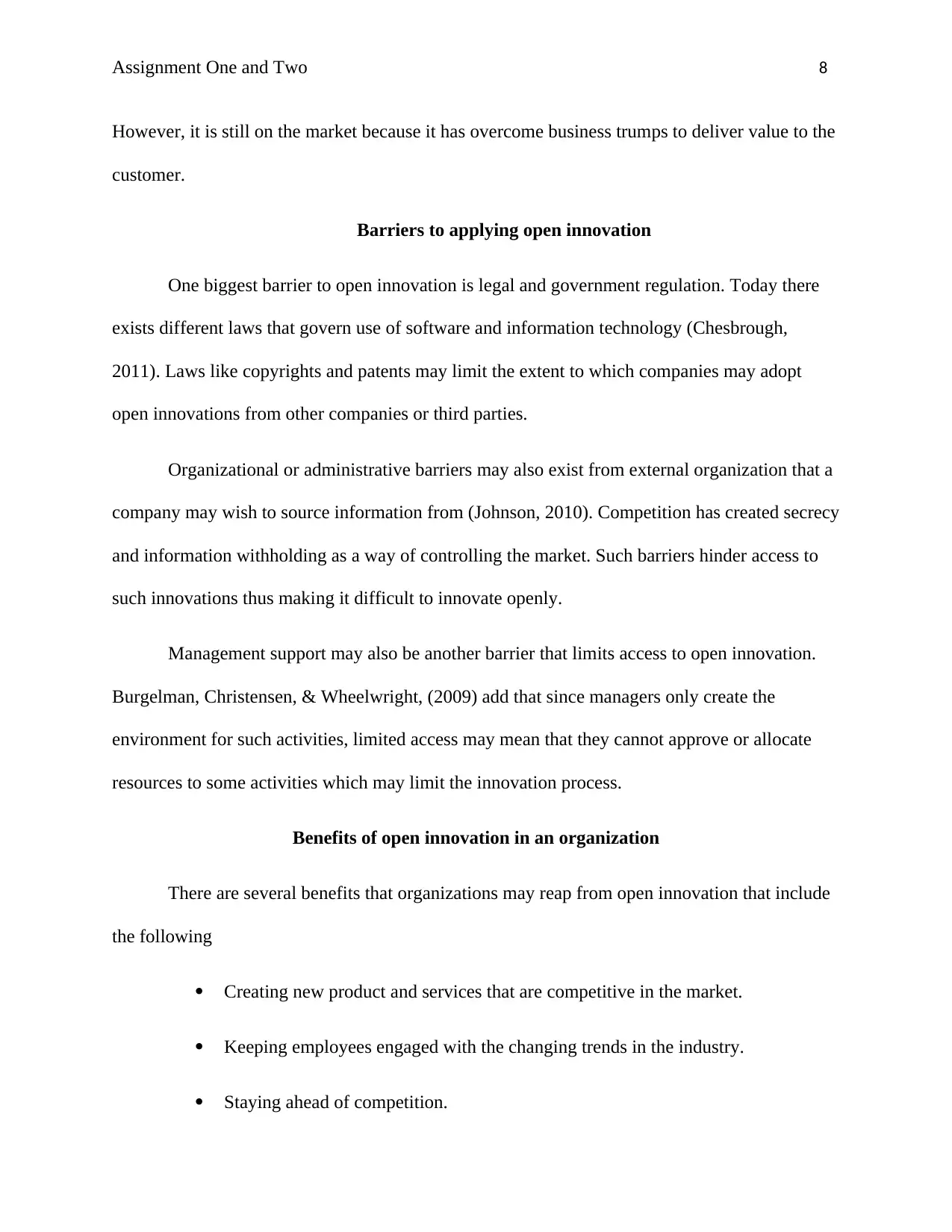
Assignment One and Two 8
However, it is still on the market because it has overcome business trumps to deliver value to the
customer.
Barriers to applying open innovation
One biggest barrier to open innovation is legal and government regulation. Today there
exists different laws that govern use of software and information technology (Chesbrough,
2011). Laws like copyrights and patents may limit the extent to which companies may adopt
open innovations from other companies or third parties.
Organizational or administrative barriers may also exist from external organization that a
company may wish to source information from (Johnson, 2010). Competition has created secrecy
and information withholding as a way of controlling the market. Such barriers hinder access to
such innovations thus making it difficult to innovate openly.
Management support may also be another barrier that limits access to open innovation.
Burgelman, Christensen, & Wheelwright, (2009) add that since managers only create the
environment for such activities, limited access may mean that they cannot approve or allocate
resources to some activities which may limit the innovation process.
Benefits of open innovation in an organization
There are several benefits that organizations may reap from open innovation that include
the following
Creating new product and services that are competitive in the market.
Keeping employees engaged with the changing trends in the industry.
Staying ahead of competition.
However, it is still on the market because it has overcome business trumps to deliver value to the
customer.
Barriers to applying open innovation
One biggest barrier to open innovation is legal and government regulation. Today there
exists different laws that govern use of software and information technology (Chesbrough,
2011). Laws like copyrights and patents may limit the extent to which companies may adopt
open innovations from other companies or third parties.
Organizational or administrative barriers may also exist from external organization that a
company may wish to source information from (Johnson, 2010). Competition has created secrecy
and information withholding as a way of controlling the market. Such barriers hinder access to
such innovations thus making it difficult to innovate openly.
Management support may also be another barrier that limits access to open innovation.
Burgelman, Christensen, & Wheelwright, (2009) add that since managers only create the
environment for such activities, limited access may mean that they cannot approve or allocate
resources to some activities which may limit the innovation process.
Benefits of open innovation in an organization
There are several benefits that organizations may reap from open innovation that include
the following
Creating new product and services that are competitive in the market.
Keeping employees engaged with the changing trends in the industry.
Staying ahead of competition.
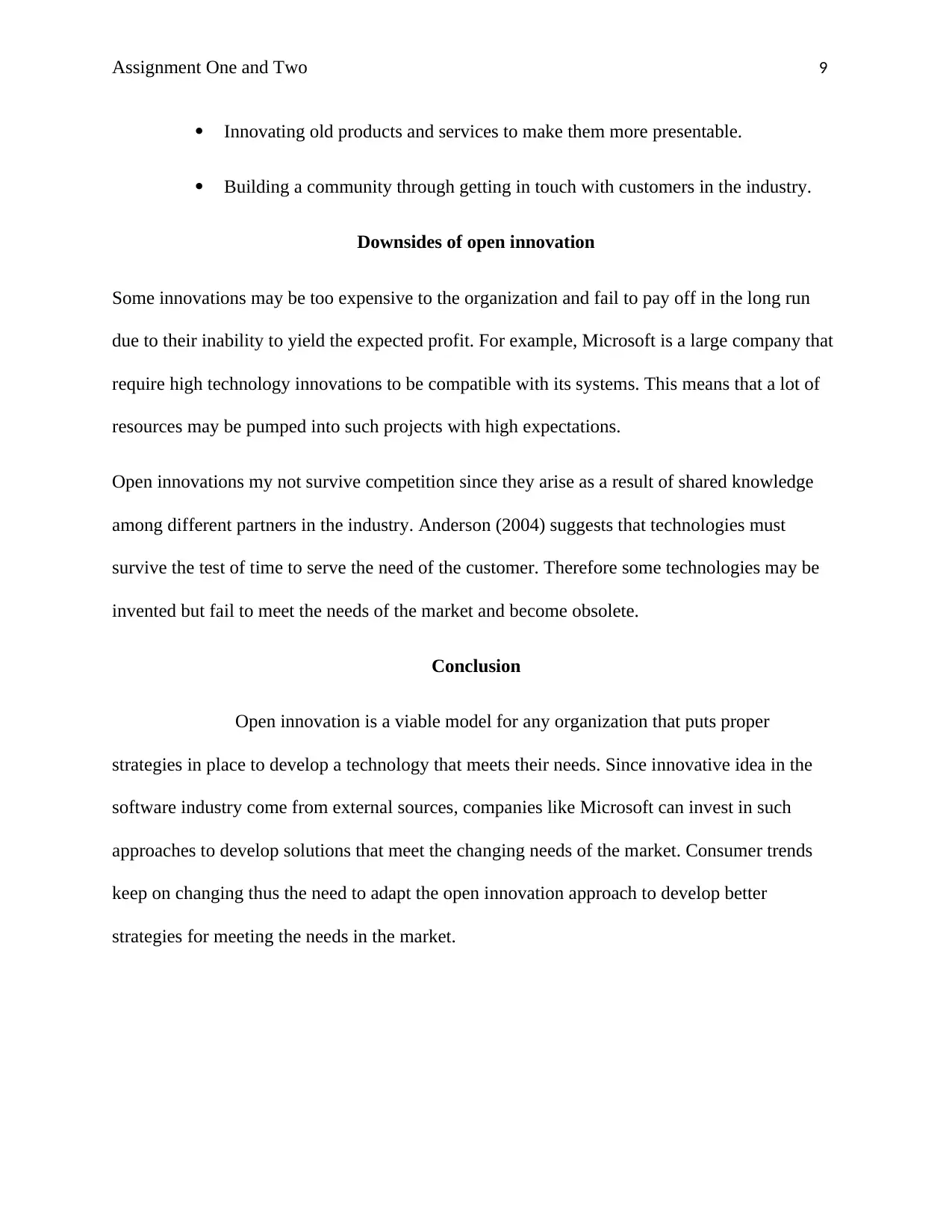
Assignment One and Two 9
Innovating old products and services to make them more presentable.
Building a community through getting in touch with customers in the industry.
Downsides of open innovation
Some innovations may be too expensive to the organization and fail to pay off in the long run
due to their inability to yield the expected profit. For example, Microsoft is a large company that
require high technology innovations to be compatible with its systems. This means that a lot of
resources may be pumped into such projects with high expectations.
Open innovations my not survive competition since they arise as a result of shared knowledge
among different partners in the industry. Anderson (2004) suggests that technologies must
survive the test of time to serve the need of the customer. Therefore some technologies may be
invented but fail to meet the needs of the market and become obsolete.
Conclusion
Open innovation is a viable model for any organization that puts proper
strategies in place to develop a technology that meets their needs. Since innovative idea in the
software industry come from external sources, companies like Microsoft can invest in such
approaches to develop solutions that meet the changing needs of the market. Consumer trends
keep on changing thus the need to adapt the open innovation approach to develop better
strategies for meeting the needs in the market.
Innovating old products and services to make them more presentable.
Building a community through getting in touch with customers in the industry.
Downsides of open innovation
Some innovations may be too expensive to the organization and fail to pay off in the long run
due to their inability to yield the expected profit. For example, Microsoft is a large company that
require high technology innovations to be compatible with its systems. This means that a lot of
resources may be pumped into such projects with high expectations.
Open innovations my not survive competition since they arise as a result of shared knowledge
among different partners in the industry. Anderson (2004) suggests that technologies must
survive the test of time to serve the need of the customer. Therefore some technologies may be
invented but fail to meet the needs of the market and become obsolete.
Conclusion
Open innovation is a viable model for any organization that puts proper
strategies in place to develop a technology that meets their needs. Since innovative idea in the
software industry come from external sources, companies like Microsoft can invest in such
approaches to develop solutions that meet the changing needs of the market. Consumer trends
keep on changing thus the need to adapt the open innovation approach to develop better
strategies for meeting the needs in the market.
⊘ This is a preview!⊘
Do you want full access?
Subscribe today to unlock all pages.

Trusted by 1+ million students worldwide
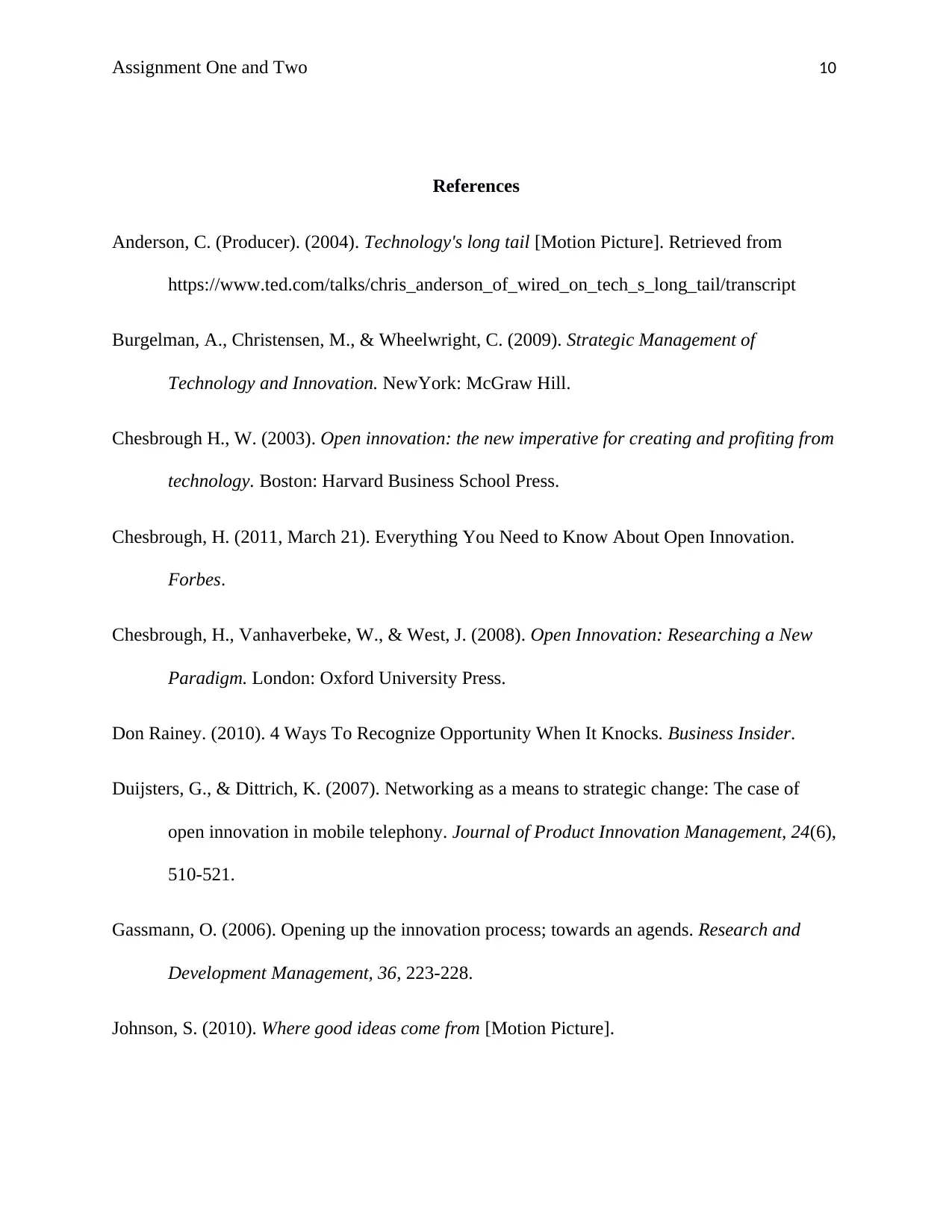
Assignment One and Two 10
References
Anderson, C. (Producer). (2004). Technology's long tail [Motion Picture]. Retrieved from
https://www.ted.com/talks/chris_anderson_of_wired_on_tech_s_long_tail/transcript
Burgelman, A., Christensen, M., & Wheelwright, C. (2009). Strategic Management of
Technology and Innovation. NewYork: McGraw Hill.
Chesbrough H., W. (2003). Open innovation: the new imperative for creating and profiting from
technology. Boston: Harvard Business School Press.
Chesbrough, H. (2011, March 21). Everything You Need to Know About Open Innovation.
Forbes.
Chesbrough, H., Vanhaverbeke, W., & West, J. (2008). Open Innovation: Researching a New
Paradigm. London: Oxford University Press.
Don Rainey. (2010). 4 Ways To Recognize Opportunity When It Knocks. Business Insider.
Duijsters, G., & Dittrich, K. (2007). Networking as a means to strategic change: The case of
open innovation in mobile telephony. Journal of Product Innovation Management, 24(6),
510-521.
Gassmann, O. (2006). Opening up the innovation process; towards an agends. Research and
Development Management, 36, 223-228.
Johnson, S. (2010). Where good ideas come from [Motion Picture].
References
Anderson, C. (Producer). (2004). Technology's long tail [Motion Picture]. Retrieved from
https://www.ted.com/talks/chris_anderson_of_wired_on_tech_s_long_tail/transcript
Burgelman, A., Christensen, M., & Wheelwright, C. (2009). Strategic Management of
Technology and Innovation. NewYork: McGraw Hill.
Chesbrough H., W. (2003). Open innovation: the new imperative for creating and profiting from
technology. Boston: Harvard Business School Press.
Chesbrough, H. (2011, March 21). Everything You Need to Know About Open Innovation.
Forbes.
Chesbrough, H., Vanhaverbeke, W., & West, J. (2008). Open Innovation: Researching a New
Paradigm. London: Oxford University Press.
Don Rainey. (2010). 4 Ways To Recognize Opportunity When It Knocks. Business Insider.
Duijsters, G., & Dittrich, K. (2007). Networking as a means to strategic change: The case of
open innovation in mobile telephony. Journal of Product Innovation Management, 24(6),
510-521.
Gassmann, O. (2006). Opening up the innovation process; towards an agends. Research and
Development Management, 36, 223-228.
Johnson, S. (2010). Where good ideas come from [Motion Picture].
Paraphrase This Document
Need a fresh take? Get an instant paraphrase of this document with our AI Paraphraser
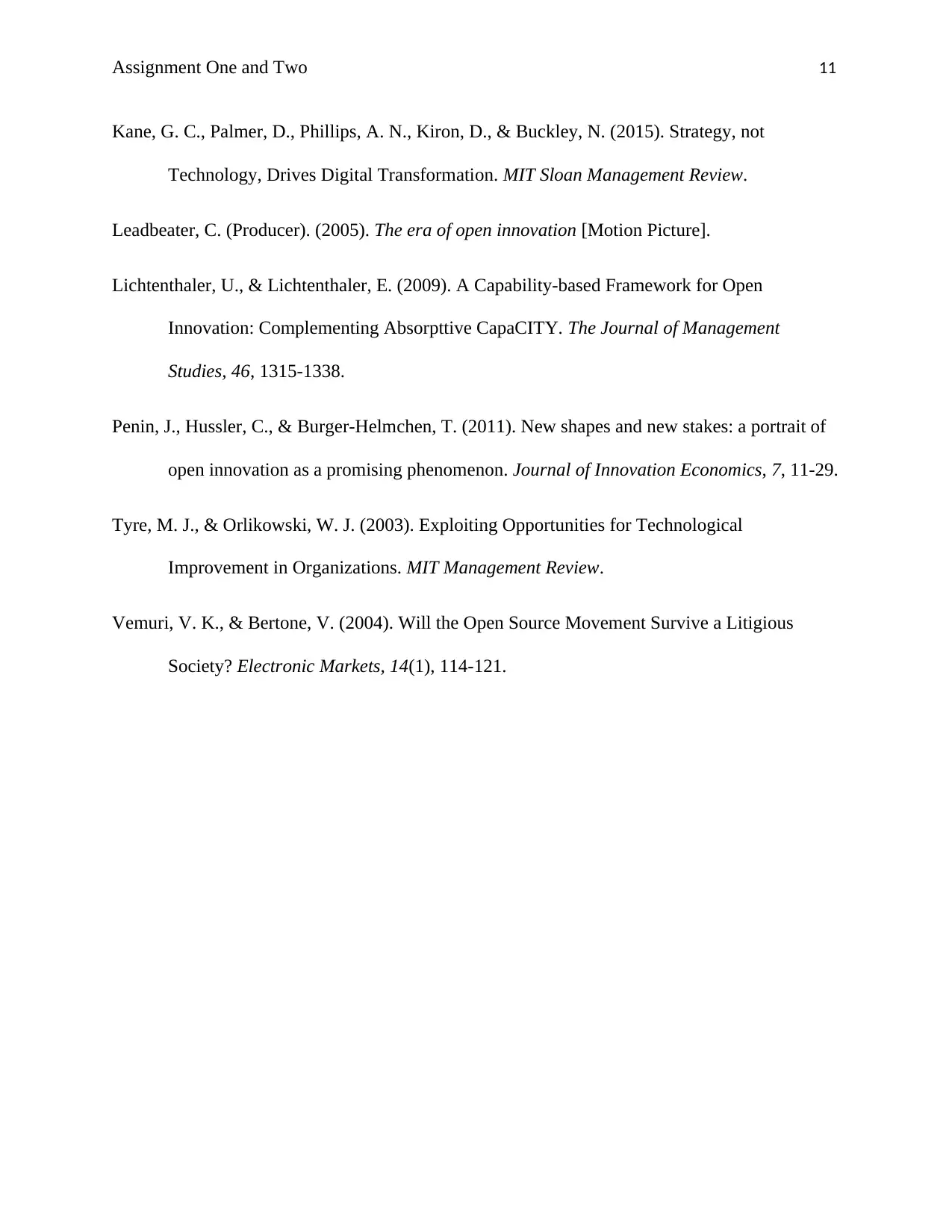
Assignment One and Two 11
Kane, G. C., Palmer, D., Phillips, A. N., Kiron, D., & Buckley, N. (2015). Strategy, not
Technology, Drives Digital Transformation. MIT Sloan Management Review.
Leadbeater, C. (Producer). (2005). The era of open innovation [Motion Picture].
Lichtenthaler, U., & Lichtenthaler, E. (2009). A Capability-based Framework for Open
Innovation: Complementing Absorpttive CapaCITY. The Journal of Management
Studies, 46, 1315-1338.
Penin, J., Hussler, C., & Burger-Helmchen, T. (2011). New shapes and new stakes: a portrait of
open innovation as a promising phenomenon. Journal of Innovation Economics, 7, 11-29.
Tyre, M. J., & Orlikowski, W. J. (2003). Exploiting Opportunities for Technological
Improvement in Organizations. MIT Management Review.
Vemuri, V. K., & Bertone, V. (2004). Will the Open Source Movement Survive a Litigious
Society? Electronic Markets, 14(1), 114-121.
Kane, G. C., Palmer, D., Phillips, A. N., Kiron, D., & Buckley, N. (2015). Strategy, not
Technology, Drives Digital Transformation. MIT Sloan Management Review.
Leadbeater, C. (Producer). (2005). The era of open innovation [Motion Picture].
Lichtenthaler, U., & Lichtenthaler, E. (2009). A Capability-based Framework for Open
Innovation: Complementing Absorpttive CapaCITY. The Journal of Management
Studies, 46, 1315-1338.
Penin, J., Hussler, C., & Burger-Helmchen, T. (2011). New shapes and new stakes: a portrait of
open innovation as a promising phenomenon. Journal of Innovation Economics, 7, 11-29.
Tyre, M. J., & Orlikowski, W. J. (2003). Exploiting Opportunities for Technological
Improvement in Organizations. MIT Management Review.
Vemuri, V. K., & Bertone, V. (2004). Will the Open Source Movement Survive a Litigious
Society? Electronic Markets, 14(1), 114-121.
1 out of 11
Related Documents
Your All-in-One AI-Powered Toolkit for Academic Success.
+13062052269
info@desklib.com
Available 24*7 on WhatsApp / Email
![[object Object]](/_next/static/media/star-bottom.7253800d.svg)
Unlock your academic potential
Copyright © 2020–2025 A2Z Services. All Rights Reserved. Developed and managed by ZUCOL.





